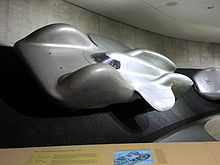Streamlined vehicle

A streamlined vehicle has a body with low drag . For this purpose, the frontal area and drag coefficient (C w ) are kept as small as possible. The air resistance increases sharply at higher speeds. The lower the air resistance, the lower the driving resistance and fuel consumption, and the higher the top speed.
development
Streamlined vehicles emerged in the 1920s and 30s. Here in were aircraft derived aerodynamic findings implemented. There were streamlined cars (including trucks), streamlined buses , streamlined motorcycles , streamlined locomotives, and streamlined trains . With a few exceptions, the forms developed at that time could not prevail due to their practical disadvantages. In automotive design , the term streamlined shape was used to describe sleek-looking shapes (such as those with a humpback ) with not particularly low air resistance.
Well-known streamlined vehicles are:
- cars
- Rumpler Teardrop Car (1921)
- Tatra 77 (from 1934)
- Chrysler Airflow (from 1934)
- Auto Union Type C Avus Streamlined Car (1937)
- Wanderer Streamline Special (1938)
- Mercedes-Benz T 80 (1939)
- BMW 328 (from 1936) with Wendler body
- Saab 92 (from 1949)
- NSU Ro 80 (from 1967)
- Truck prototype by designer Luigi Colani
- motorcycles
- NSU Delphin III (1956)
- Baumm -NSU (1954)
- Rail vehicles
- Rail zeppelin (1929)
- Flying Hamburger (1933)
- Henschel-Wegmann Train (1935)
- DR series 05 (1935)
- Ships
Streamlined steam locomotive NS 3801
literature
- Ralf JF Kieselbach: Streamlined Cars in Europe and the USA. Aerodynamics in car construction 1900 to 1945. Kohlhammer, Stuttgart 1982, ISBN 3-17-007627-2
- Ralf JF Kieselbach: Streamlined buses in Germany. Aerodynamics in commercial vehicle construction 1931 to 1961. Kohlhammer, Stuttgart 1983, ISBN 3-17-007930-1







